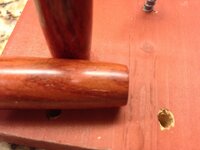Bowhnter
Member
I am making a few Big Ben click pens. This Burmese Rosewood looks good, but, as with some previous blanks I have turned or finished regardless of style, have what looks like small cracks in the finish but is part of the wood.
So, the question is, am I supposed to seal these, and would that clear sealer even conceal the marks?
Or do I toss the blank and start over, or is it still sellable as is? Do people understand it is a characteristic of the wood or would they not like it? My wife didn't even notice, and when I pointed it out said it wouldn't bother her.
It's a blo ca finish btw.
Thanks for the advice.
So, the question is, am I supposed to seal these, and would that clear sealer even conceal the marks?
Or do I toss the blank and start over, or is it still sellable as is? Do people understand it is a characteristic of the wood or would they not like it? My wife didn't even notice, and when I pointed it out said it wouldn't bother her.
It's a blo ca finish btw.
Thanks for the advice.

